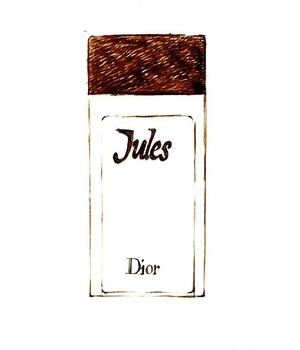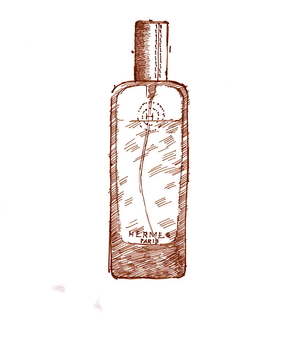Tagged With ‘coumarin’
Christian Dior
Jules
21 August, 2015
 Sage isn’t everyone’s favourite herb, though turkey stuffing wouldn’t the same without it. It’s used less often in perfumery than in cooking, but Jules shows what a great ingredient it can be in the hands of a brilliant perfumer.
Sage isn’t everyone’s favourite herb, though turkey stuffing wouldn’t the same without it. It’s used less often in perfumery than in cooking, but Jules shows what a great ingredient it can be in the hands of a brilliant perfumer.
The ‘nose’ in this case was Jean Martel, who worked for the French fragrance company Givaudan in the 1970s and 1980s and deserves to be far better known, not least because he also created that 1970s classic, Paco Rabanne for Men.
Jules was launched in 1980, with a brilliant advertising campaign featuring posters by René Gruau, arguably the greatest fashion illustrator of the last century, which helped the first bottles sell out in record time. Martel combined sage (which has a slightly catty smell) with cedar and other things like wormwood, lavender and bergamot. To me the result smells like sage and slightly peppery leather, though there’s a long list of other ingredients, including cumin, sandalwood, oakmoss, jasmine, musk and rose.
Despite its initial success, Jules has since been overshadowed by the success of Kouros, which was launched the following year. Created for Yves Saint Laurent by the brilliant Pierre (Cool Water) Bourdon, Kouros shares Jules’ clean / dirty / sexy character, and both scents belong to the same fragrance ‘family’, the fougères – a style of perfumes, usually aimed at men, based on a combination of lavender and coumarin (originally derived from tonka beans but usually synthesised).
Of course, Kouros’ ongoing popularity may be because it’s inherently superior to Jules, but actually I think it’s more to do with the fact that over the years Kouros has benefited from regular advertising, while Dior seems to have forgotten that Jules ever existed, which I think is a terrible shame.
To make matters worse, while you can buy Kouros pretty much anywhere, Jules has become ridiculously hard to find: I don’t know anywhere in the UK that sells it, and even in Paris the only place that seems to stock it is the department store Bon Marché, though you can buy it from Dior’s French website. Given Dior’s apparent lack of interest, it’s a wonder it hasn’t been discontinued, but I’m glad it’s still on sale, even if it’s now a rarity.
I can only hope that one day they decide to invest in promoting it again and making it available to all – but in the meantime if you want something special that very few other people will have, get over to Bon Marché.
Hermès
Vétiver Tonka
18 August, 2014
 Like several other major perfume and fashion brands, Hermès has, in recent years, organised its range of perfumes into a number of different groups. I’m guessing that this is partly to help them refine their message for different segments of the market, but I also wonder whether it has something to do with their in-house perfumer, Jean-Claude Ellena, trying to bring order to a rather disparate collection of scents, in the way that a newly appointed curator might attempt to impose order on a rather muddled art collection.
Like several other major perfume and fashion brands, Hermès has, in recent years, organised its range of perfumes into a number of different groups. I’m guessing that this is partly to help them refine their message for different segments of the market, but I also wonder whether it has something to do with their in-house perfumer, Jean-Claude Ellena, trying to bring order to a rather disparate collection of scents, in the way that a newly appointed curator might attempt to impose order on a rather muddled art collection.
Whether intentionally or not, the groups have been divided in a way that reflects the gradual shift away from gendered to genderless scents, with most of the pre-Ellena perfumes being assigned, in the old-fashioned way, to either women or men (men getting Bel Ami, Equipage and Terre d’Hermès). By contrast most of the more recent scents are categorised by type, not gender, and described as ‘for sharing’ – currently five in Les Colognes collection, four in Les Jardins and eleven in the much more expensive Hermessences range, leaving Eau d’Hermès and Voyage d’Hermès standing on their own.
I’m guessing that the mass-market scents – Voyage and Terre d’Hermès – bring in most of the cash, but what seems to interest Hermès most (and, by extension, Jean-Claude Ellena) are the Hermessences: there are already more of them than there are in any other range, and they’re the only fragrances for which the company does its own in-house PR. They’re also almost twice the price of other Hermès scents: £161 for a 100ml eau-de-toilette as opposed to £73-£80 for a 100ml eau-de-toilette from any of the other groups.
Given how much they cost, you’d expect the Hermessences to be more unusual and have more staying-power than Hermès’ other perfumes, and at least in the case of Vétiver Tonka, that seems to be true. One often-repeated criticism of Jean-Claude Ellena is that the perfumes he creates tend towards the light and evanescent – delicate compositions that disappear all too quickly on the skin. Some people might regard that as a good thing, but as a value-for-money Yorkshireman I want to get some bang for my buck.
Vétiver Tonka certainly lasts, so that’s a good start. It’s also unusual, which for me is another plus – so many perfumes smell almost identical these days. But unusual doesn’t always mean attractive, or even wearable – just smell the amazing Bulgari Black, which is a brilliant scent, but also almost unwearable, at least outside a nightclub. Vétiver Tonka certainly isn’t in that league, but nor does it fit into an easily recognisable ‘normal’ category of scents.
Vetiver, of course, is a classic ingredient of many perfumes aimed at men: extracted from the roots of a tropical grass, it smells earthy and dry, but also fresh; it has the added advantage of being extremely long-lasting, and it can enhance the longevity of other ingredients too. The vetiver that Jean-Claude Ellena has used here, though, is a smoother, less rough-edged extract, which makes the perfume smell perhaps a little more feminine than I’d normally expect.
Tonka – the perfume ingredient, not the toy company – comes from the beans of the cumaru tree, Dipteryx odorata, which grows in Central America and, like laburnum and wisteria, belongs in the pea family. These beans yield coumarin, a chemical that was often used as a cheaper substitute for vanilla; coumarin also smells a bit like cinnamon, almonds or cloves, all of which I get traces of in Vétiver Tonka.
In many ways this is a perfume that does what it says on the tin, for if you can imagine the earthy smell of vetiver mixed with the foody smell of tonka (which many people find slightly chocolatey, probably because of its association with chocolate), then that’s pretty much how Vétiver Tonka smells. The vetiver helps it last all day, but what I mostly smell is the tonka, doubtless blended with many other things – there’s a gentle nuttiness, a bit like rum or sherry, or even a kitchen in the middle of baking day.
When I asked my mum what she thought of it she said, ‘It’s a very nice smell, but it doesn’t really smell like a perfume,’ and I think that pretty much sums it up. Not something you’d necessarily want to adopt as a signature scent, but a quality perfume to try if you fancy smelling a bit out of the ordinary. It also comes in a very nice Hermès box (with a rather cheap-looking cloth bag inside), and the clear-glass bottle – cleverly suffused with pale green – is satisfyingly chunky, with a stitched-leather cap, though whether all that makes it £161 I’m still not sure.